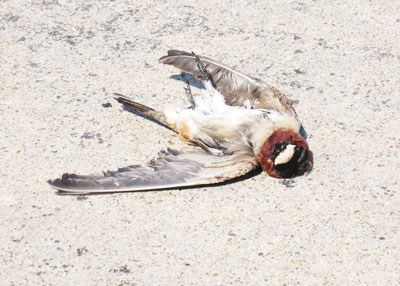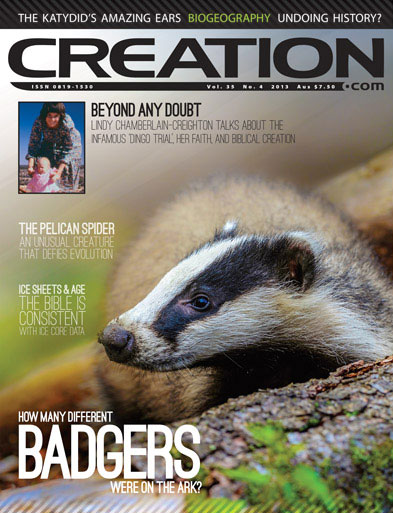Traffic clips wings

According to a news headline: “Birds evolving to dodge traffic”.1 Another proclaimed,“Evolution via Roadkill”.2 The articles were reporting research on changes in cliff swallows3 in southwestern Nebraska, USA. Since 1982, researchers have been conducting detailed annual surveys of the colonies of thousands of these birds that build mud nests on highway bridges, overpasses and road culverts in the area.
The researchers collected the carcasses of cliff swallows hit by vehicles, and discovered that road kill victims had longer-than-average wingspans, right through the study period. In 2012, for example, the average cliff swallow in the population had a 106-mm wingspan, whereas the average wingspan of roadkill swallows was 112 mm. What’s more, as the years passed, fewer and fewer birds were being hit by cars, even though the numbers of nests and birds had more than doubled, while the amount of traffic on the roads had remained steady.4
The decline in road kill wasn’t the only change the researchers observed during the 30-year study. The difference in wing length between the birds killed on roads and the population at large became greater year by year. That is, the average wing length of the population as a whole became shorter, from 111 mm in 1982 to the 106-mm average in 2012.

Why should this be? The researchers wrote in their paper in the journal Current Biology:
“One possible explanation is that selection has favored individuals whose wing morphology allows for better escape. Longer wings have lower wing loading and do not allow as vertical a take-off as shorter, more rounded wings. Thus, individuals sitting on a road, as cliff swallows often do, who are able to fly upward more vertically may be better able to avoid or more effectively pivot away from an oncoming vehicle.”4
So, birds with longer wings would be more likely to be killed by vehicles and less likely to reproduce—thus not passing on their ‘long-wing’ genes to the next generation.
This gave rise to the headline that birds are ‘evolving’ to dodge heavy traffic. “Evolution is an ongoing process,” explained lead researcher Professor Charles Brown of the University of Tulsa, “and all this—roads, SUVs5, and all—is part of nature or ‘the wild’; they exert selection pressures in a way we don’t usually think about.”1
But exerting ‘selection pressure’ (whether by natural selection or by some human-caused selection pressure as is happening here) is not the same thing as ‘evolution’—a process which we are so often told is responsible for having turned microbes into man over millions (even billions) of years. The cliff swallows are not ‘evolving’ some new feature that helps them survive modern traffic. In as much as selection pressure on wingspan is at work here (Professor Brown acknowledges that changed behaviour could also be a factor6), we are simply seeing a culling, a removal from the population, of birds having long wings, with the already-existing shorter-winged birds surviving to pass on their genes to the next generation.

This study, and the reporting of it, is a classic example of the confusing way that the terms ‘evolution’ and ‘natural selection’ are bandied about as if synonymous.7 They are not. Sadly, many people are duped by the ‘evolution’-proclaiming headlines into thinking that scientists have evidence of the sorts of changes needed for bacteria to have turned into birds over millions of years. But no, the only thing observed is natural selection. The culling action of natural selection can alter the genetic makeup of a population quickly—something that frequently catches evolutionary researchers by surprise,8 as they are often prisoner to ideas of slow-and-gradual change and confused in their own minds as to the evolution / natural selection distinction.9 Professor Brown was wrong to invoke ‘evolution’, but absolutely right when he told ScienceNOW: “This is a clear example of how you can observe natural selection over short time periods.”2
Thus at most here we are simply seeing a change in frequency of already-existing genes in the cliff swallow population, as the genes for short wings are favoured over those for long wingspans. So there’s no evolution to see here, as the traffic ‘selection pressure’ can only clip existing wings, it cannot create wings!10
Re-posted on homepage: 14 July 2021
References and notes
- Holland, M., Birds evolving to dodge traffic, news.com.au, 20 March 2013. Return to text.
- Williams, S., Evolution via Roadkill, news.sciencemag.org, 18 March 2013. Return to text.
- Petrochelidon pyrrhonota. Return to text.
- Brown, C. and Brown, M., Where has all the road kill gone? Current Biology 23(6):R233–R234, 2013. Return to text.
- SUV=sport utility vehicle, i.e. vehicles able to be taken in off-road terrain. Return to text.
- Although the researchers could not directly evaluate the behavioural/learning aspect, they pointed out that if individual birds are likely to avoid cars after a close encounter, then one would expect younger birds to be overrepresented among the road kills—but they were not. Return to text.
- Walker, T., Don’t fall for the bait-and-switch, Creation 29(4):38–39, 2007; creation.com/baitandswitch. Return to text.
- Catchpoole, D. and Wieland, C., Speedy species surprise: The rapid appearance today, of new varieties of fish, lizards, and more defies evolutionary expectations … but fits perfectly with the Bible, Creation 23(2):13–15, 2001; creation.com/speedy. Return to text.
- Catchpoole, D., Defining terms—Evolutionist Dr John Endler’s refreshing clarity about ‘natural selection’ has been largely ignored, creation.com/defining-terms, 11 January 2011. Return to text.
- For more on how the changes that are observed in living things is in no way evidence of evolution see: Catchpoole, D., The 3 Rs of Evolution: Rearrange, Remove, Ruin—in other words, no evolution!, Creation 35(2):47–49, 2013; creation.com/3-Rs-of-evolution. Return to text.






Readers’ comments
Comments are automatically closed 14 days after publication.